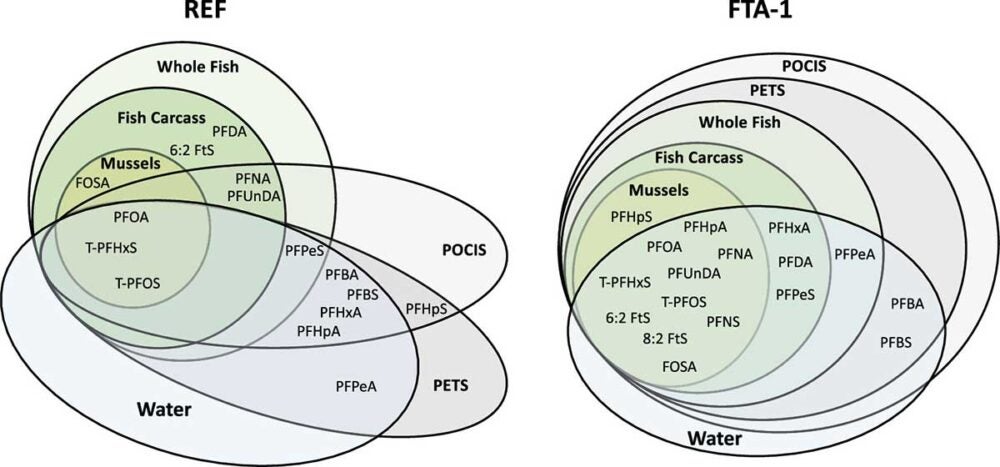Aqueous film-forming foams (AFFF) were historically deployed for fire department training activities on Joint Base, Cape Cod, Massachusetts, and resulted in extensive groundwater PFAS contamination. STEEP researchers evaluated uptake of PFAS in fish, mussels, and passive samplers, from two groundwater sources with contrasting low (reference site) and high (PFAS plume site) concentrations. The focus of the study was to determine if PFAS uptake from mixtures varies as a function of concentration and composition, between aquatic species and sex, and if passive samplers provide a proxy for aquatic organisms.
The mobile-laboratory experiments, on-site, allowed for a continuous capture of PFAS exposures over 21 days, examining uptake of male and female fathead minnows, freshwater mussels, and passive samplers. The groundwater composition was complex; 9 PFAS were detected in the reference groundwater and 17 PFAS were detected in the contaminated groundwater. PFAS concentrations in aquatic species generally increased with increasing PFAS chain length.
Uptake for most PFAS in male fish increased over time, whereas female fish uptake indicated an initial increase in concentrations followed by a decrease. Uptake of PFAS was less in mussels, but also increased and then decreased.
PFAS uptake by passive samplers largely mimicked uptake by fish, but not by mussels, suggesting that passive samplers are useful screening tools for PFAS that bioconcentrate in fish but are below the minimum concentration for detection in water. In addition, passive samplers can assess exposure to short-chain PFAS not detected in biota. Unfortunately, passive samplers are not sensitive enough to capture longer-chain PFAS accumulating in aquatic species.
Understanding the complexities PFAS bioconcentration in contaminated groundwater helps to assess potential impacts on aquatic organisms. Additionally, the mobile-laboratory approach incorporates the dynamics of natural systems, and accounting for variability is realistic; environmental conditions do not exist in the “steady state” of a traditional lab.
Figure shows the overlap in the detection of individual PFAS in organisms, water, polar organic chemical integrative samplers (POCIS), and polyethylene tube samplers (PETS), exposed to groundwater from the reference (REF) and fire training area contaminated (FTA-1) wells during the 2018 mobile-laboratory experiments conducted on Cape Cod, Massachusetts.
Barber, L.B., Pickard, H.M., Alvarez, D.A., Becanova, J., Keefe, S.H., LeBlanc, D.R., Lohmann, R., Steevens, J.A., Vajda, A. 2023. Uptake of per- and polyfluoroalkyl substances by fish, mussel, and passive samplers in mobile-laboratory exposures using groundwater from a contamination plume at a historical fire training area, Cape Cod, Massachusetts. Environmental Science & Technology 2023 57 (14), 5544-5557 [DOI: 10.1021/acs.est.2c06500]

